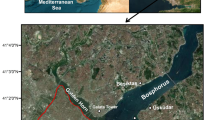Abstract
This paper introduced a developed object-based extraction tool for delineating the building footprints from high-resolution satellite image. The foundation of the algorithm is a scale-space analysis based on level set transformation integrated with index, size, shape and spatial relation analysis. Building extraction tool is developed as a component of a newly developed tsunami early damage detection system. To be capable as a tool in such critical time after a catastrophe, the tool is implemented in a parallel manner for processing speed optimization. The extracted building footprint plays as one of the roughness factors in tsunami numerical modeling. The test on QuickBird image of Ban Nam Ken, Phanga, Thailand presents a good result in comparison with manually detected one. It infers that the tool is applicable in extraction of other object types from high-resolution satellite images. It is also recommended that benchmark should be carried out to report the algorithm performance based on which improvement can be made.





Similar content being viewed by others
References
Adams BJ, Huyck CK, Mansouri B, Eguchi RT and Shinozuka M (2004) Application of high-resolution optical satellite imagery for post-earthquake damage assessment: The 2003 Boumerdeas (Algeria) and Bam (Iran) earthquakes. Multidisciplinary Center for Earthquake Engineering Research Progress and Accomplishments 2003–2004, University of Buffalo. http://mceer.buffalo.edu/publications/resaccom/04-SP01/12_Eguchi.pdf (Accessed 20 Dec. 2007)
Chesnel A-L, Binet, R, and Wald L (2007) Damage assessment on buildings using very high resolution multimodal images and GIS. In: Proceedings of 5th International Workshop on Remote Sensing, George Washington University, Washington D.C., USA.
Hay GJ, Blaschke T, Marceau DJ, Bochard A (2003) A comparison of three image-object methods for the multiscale analysis of landscape structures. ISPRS J Photogramm Remote Sens 57(5–6):327–345
Hill AA, Keys-Mathews LD, Adams BJ and Podolsky D (2006) Remote sensing and recovery: a case study on the Gulf Coast of the United States. Proceeding of the 4th International Workshop on Remote Sensing for Post-Disaster Response, Cambridge, United Kingdom, CDROM.
Koshimura S and Yanagisawa H (2007) Developing fragility functions for tsunami damage estimation using the numerical model and satellite imagery. Proceedings of the 5th International Workshop on Remote Sensing for Post Disaster Response, Washington D.C., USA.
Meyer F, Maragos P (2000) Non-linear scale-space representation with morphological levelings. J Vis Commun Image Represent 11:245–265
Saito K, Spence RJS, Going C, Markus M (2004) Using high-resolution satellite images for post-earthquake building damage assessment: a study following the 26 January 2001 Gujarat earthquake. Earthquake Spectra 20(1):145–169
Serra J (1982) Image analysis and mathematical morphology. Academic, London
Swain MJ, Ballard DH (1991) Color indexing. Int J Comput Vision 7(1):11–32
Vu TT (2008) Monitoring the recover process of the disaster-affected areas—scaling contextual approach and its implementation on GEO grid cluster. Proceedings of the XXI ISPRS Congress, Beijing, 3–11 July 2008
Vu TT, Matsuoka M, Yamazaki F (2005) Detection and animation of damage using very high-resolution satellite data following the 2003 Bam, Iran, earthquake. Earthquake Spectra 21(S1):S319–S327
Vu TT, Matsuoka M, Yamazaki F (2007) Dual-scale approach to detect the tsunami-affected areas using optical satellite images. Int J Remote Sens 28(13–14):2995–3011
Acknowledgement
This research is a part of an internationally collaborative research project supported by Industrial Technology Research Grant Program from New Energy and Industrial Technology Development Organization (NEDO), Japan.
Author information
Authors and Affiliations
Corresponding author
Rights and permissions
About this article
Cite this article
Vu, T.T. Building extraction from high-resolution satellite image for tsunami early damage estimation. Appl Geomat 3, 75–81 (2011). https://doi.org/10.1007/s12518-010-0039-4
Received:
Accepted:
Published:
Issue Date:
DOI: https://doi.org/10.1007/s12518-010-0039-4




